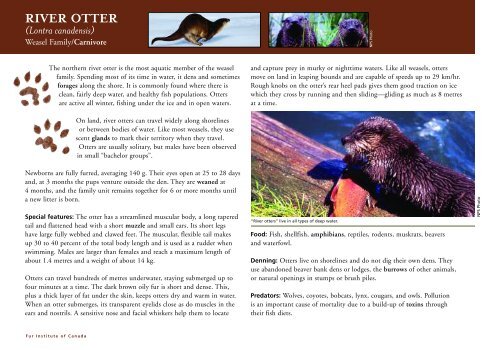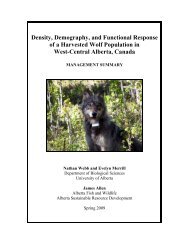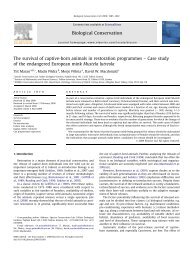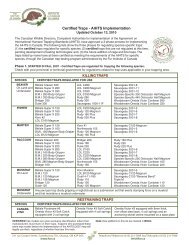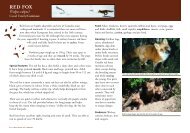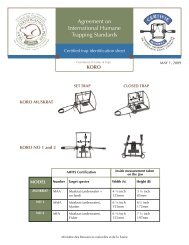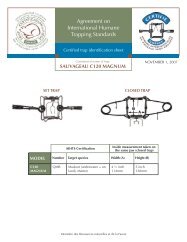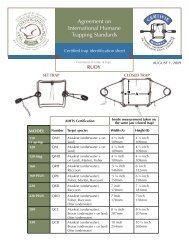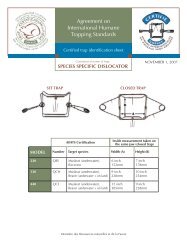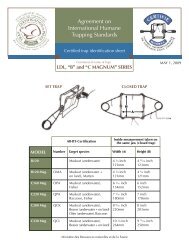You also want an ePaper? Increase the reach of your titles
YUMPU automatically turns print PDFs into web optimized ePapers that Google loves.
<strong>RIVER</strong> <strong>OTTER</strong>(Lontra canadensis)Weasel Family/CarnivoreNPS PhotoThe northern river otter is the most aquatic member <strong>of</strong> the weaselfamily. Spending most <strong>of</strong> its time in water, it dens and sometimesforages along the shore. It is commonly found where there isclean, fairly deep water, and healthy fish populations. Ottersare active all winter, fishing under the ice and in open waters.and capture prey in murky or nighttime waters. Like all weasels, ottersmove on land in leaping bounds and are capable <strong>of</strong> speeds up to 29 km/hr.Rough knobs on the otter’s rear heel pads gives them good traction on icewhich they cross by running and then sliding—gliding as much as 8 metresat a time.On land, river otters can travel widely along shorelinesor between bodies <strong>of</strong> water. Like most weasels, they usescent glands to mark their territory when they travel.Otters are usually solitary, but males have been observedin small “bachelor groups”.Newborns are fully furred, averaging 140 g. Their eyes open at 25 to 28 daysand, at 3 months the pups venture outside the den. They are weaned at4 months, and the family unit remains together for 6 or more months untila new litter is born.Special features: The otter has a streamlined muscular body, a long taperedtail and flattened head with a short muzzle and small ears. Its short legshave large fully webbed and clawed feet. The muscular, flexible tail makesup 30 to 40 percent <strong>of</strong> the total body length and is used as a rudder whenswimming. Males are larger than females and reach a maximum length <strong>of</strong>about 1.4 metres and a weight <strong>of</strong> about 14 kg.Otters can travel hundreds <strong>of</strong> metres underwater, staying submerged up t<strong>of</strong>our minutes at a time. The dark brown oily fur is short and dense. This,plus a thick layer <strong>of</strong> fat under the skin, keeps otters dry and warm in water.When an otter submerges, its transparent eyelids close as do muscles in theears and nostrils. A sensitive nose and facial whiskers help them to locate“River otters” live in all types <strong>of</strong> deep water.Food: Fish, shellfish, amphibians, reptiles, rodents, muskrats, beaversand waterfowl.Denning: Otters live on shorelines and do not dig their own dens. Theyuse abandoned beaver bank dens or lodges, the burrows <strong>of</strong> other animals,or natural openings in stumps or brush piles.Predators: Wolves, coyotes, bobcats, lynx, cougars, and owls. Pollutionis an important cause <strong>of</strong> mortality due to a build-up <strong>of</strong> toxins throughtheir fish diets.NPS Photo<strong>Fur</strong> <strong>Institute</strong> <strong>of</strong> <strong>Canada</strong>
Distribution:All Provinces and TerritoriesMaturity:2-3 years (female)5-6 years (male)<strong>RIVER</strong> <strong>OTTER</strong>(Lontra canadensis)Weasel Family/CarnivoreAverage life span:8 to10 yearsMating:March and AprilYoung born:March and AprilGestation:288 to 380 days due todelayed implantation(active gestation 60-63 days)1 litter a year/Average 2 to 3 pups.Habitat:Wide variety <strong>of</strong> freshwater andmarine habitats, including ponds,lakes, rivers, marshes, wetlands,coastal shorelines and estuaries.25Management Issues:Especially sensitive to environmentalpollutants in water and will disappearfrom polluted areas.


